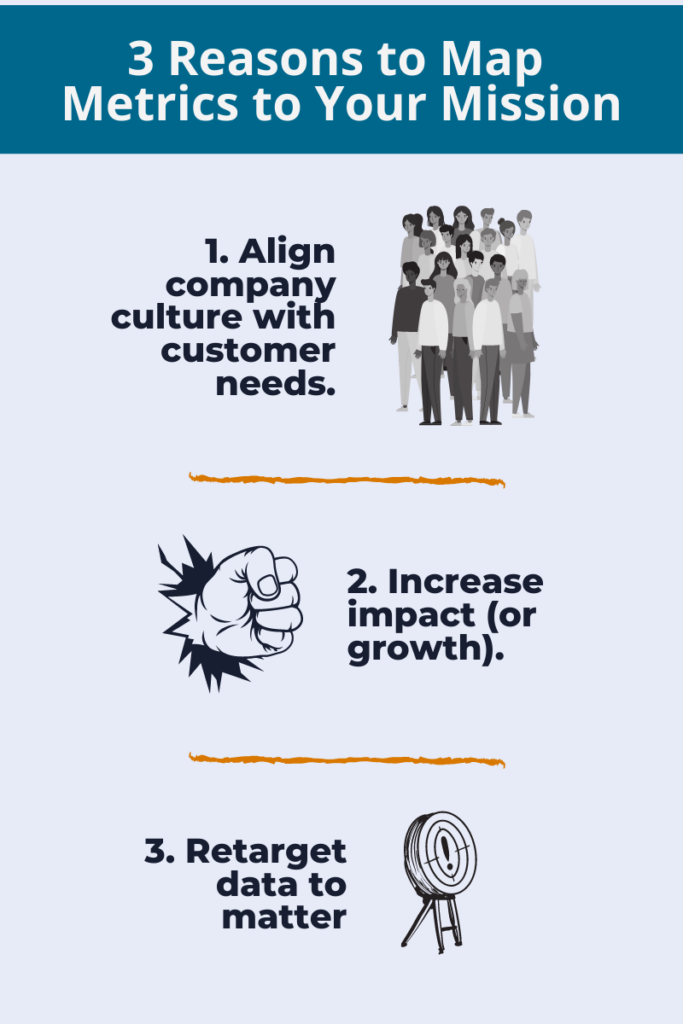When you’re strategic planning, do you map back metrics to your mission? If you’ve read any of our budgeting articles you’re familiar with my recommendation to set targets or benchmarks for your team. Creating this culture of growth sets your business up to scale.
To grow your business, especially in an unpredictable economy, you must bridge your daily operations with those financial benchmarks. So how do you go about doing that in all financial climates and why is it critical to your success?
Why map metrics to your mission statement
In this case I think the “why” is more obvious than the “how.” That said, Porch makes this great point when referring to setting up an eco-friendly business: purpose should drive your marketing in a socially responsible business model. The same principle should apply to your metrics as well. It is essential to choose metrics that align with your purpose and have a clear intention behind them.
It’s easy to get overwhelmed with the number of available analytics you could track, but that doesn’t mean they are all what you should track. Here are three good reasons to map metrics to your mission:
- By designing your operational metrics for employees to follow, you encourage your team to be “marching to the same mission” so your everyday operations tie back to your mission and vice versa. Understanding your metrics from this perspective provides an opportunity to have your customers culturally align with you. More to come on this below.
- The process of digging into your analytics drives organizational change for more impact; or growth if you’re in the business of profit.
- Finally, when you map your metrics to your mission, you retarget your data to matter. Focus on too many metrics and you lose sight of your mission.

How to map metrics to your mission impact
Begin by quantifying your mission.
These reasons all sound nice in theory, but it’s not always easy to put numbers or metrics in place of the values written out in carefully crafted mission statements.
To gauge your mission’s success or impact, at a certain point you will need to track results. Consider the measurability of your KPIs: the number, percentage, ratio or sum for example. Think about the measures that matter most to your mission, then think about how you might quantify them. Let’s look at a couple of examples.
Examples of how to measure mission impact
SaaS/Tech Metrics to Mission Statement Example
Dropbox Mission Statement
The mission of Dropbox is to simplify life for people around the world. Dropbox lets people bring their docs, photos and videos everywhere and share them easily.
Dropbox might map the amount of storage on average back to its mission statement. The more storage each customer has, the more they are using it, the more they rely on it, the stickier the customer is and ultimately one could say the more Dropbox is simplifying the life of those people.
Another less obvious metric might be to look at what similarities their best customers have and quantify those qualities. For example, they might track the number of shared links and folders. In doing so, Dropbox would be tracking the inherent marketing essential to a growth strategy built around sharing; a viral component that equally helps their customers.
Nonprofit Metrics to Mission Statement Example
As an accountant, I default to profit margins; but in Raman Chadha’s (of the Junto Institute) world he begins with the people metrics. After a recent roundtable we held with Junto, when I brought up mapping metrics to your mission, he considered it from the perspective of targeting customers and clients that are culturally aligned with your mission statement. There is a lot of value in understanding your most engaged customer. I think this is particularly true in the nonprofit sector.
Feeding America Mission Statement
Our mission is to feed America’s hungry through a nationwide network of member food banks and engage our country in the fight to end hunger.
Obvious metrics to track include number of people fed, number of volunteers, and number of donors, but to track the success of their mission statement they might want to dig a little deeper. Feeding America has made this easier by including the word “engage” right in their mission statement. Really what that tells me, is that this nonprofit has already mapped metrics to its mission. Engagement would undoubtedly play a direct role in acquiring more financially viable support.
While measuring engagement looks different depending on what department you work in (number of volunteers in program management, number of monthly donors in fundraising, etc.) there are additional people metrics that might hold statistically significant impact as it relates to the mission statement. One way our nonprofit accounting services might suggest nonprofits measure impact is with lead scoring.
Example of lead scoring.
So, for example, Feeding America might wish to perform lead scoring for their supporters, e.g., more passive engagement should score lower and more active engagement should score higher:
- likes content on social media = 1
- subscribes to a newsletter = 3
- shares content on social media = 4
- recruits new volunteer = 5
- becomes monthly donor = 7
By assigning different values for different types of engagement and activity, Feeding America can measure and determine which donors and volunteers are the most culturally aligned to build toward their “nationwide network” objective.
6 tips to measure impact of your mission statement
1). Start with your revenue and work your way backward.
Some people say revenue cures all. As long as you can grow your revenue your business can make it. That’s not 100% true but it’s always a good place to start. Revenue is the most volatile number but it is the most important. Even if you are focused on people metrics more than profit metrics, your revenue drives your operation.
2). Avoid vanity metrics.
It’s tempting to be excited by things like percentage increase in registered users but it holds little value for impact on a mission statement. Instead, track retention, usage, or sharing.
3). Sometimes a counter-metric may be the helpful measure.
For example, for many SaaS and service-based businesses, customer churn is a highly useful metric and can be directly tied to their mission statement. Tracking churn in our Dropbox example would suggest how many people they are successfully “simplifying life” for.
4). Prioritize your metrics.
Limit yourself to only the most essential drivers to your mission. How do you do this? Begin by combining data sets where possible to be more impactful to your mission. Think of the lead scoring example from above. Feeding America might combine analytics like subscriptions, shares, and number of donations into one score. List out the indicators you’re currently tracking and determine whether you can map them back to your mission– if not, maybe you can ditch them or at the very least deprioritize them.
5). Include time as a backdrop to measure your metrics against.
In different climates, your measures and their impact on your mission may change. Further quantify your metrics by comparing them on a quarterly basis or more often if the economic climate calls for it.
6). Make tracking analytics easy.
Finally, ensure the data is easily tracked by your existing systems. If your CRM or ERP isn’t providing you with analytics you can easily measure and map back to your mission, you’re missing out on the benefit of real-time data.
Ready to begin mapping your metrics to your mission statement? Get in touch and see how our Cloud CFO services help you get real-time insight into your data.


